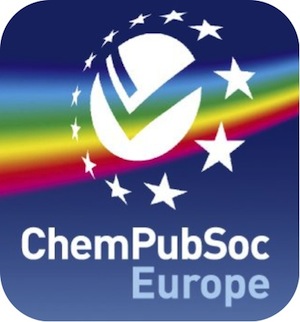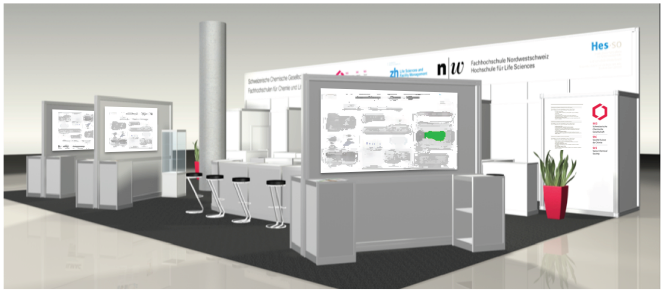EuCheMS Newsletter 09/2013
![]()
Articles
- Budapest: EuCheMS meetings and Energy Conference
- Report on organic electronics
- Germany’s chemistry conference in Darmstadt
- Events 2013/14
- News from the European Chemistry Thematic Network
More information:
http://www.euchems.ch
David Spichiger, SCS
30.07.2013
Internationale Chemie-Olympiade in Moskau: Dreimal Bronze für die Schweiz!
Je eine Bronzemedaille gewannen die beiden Zürcher Boris Stolz (Kantonsschule Hohe Promenade, ZH) aus Pfaffhausen und Patrik Willi (Kantonsschule im Lee, ZH) aus Neftenbach sowie der Berner Mario de Capitani (Gymnasium Neufeld, BE) aus Bern an der 45. Internationalen Chemie-Olympiade (IChO) 2013 in Moskau (Russland). Mit diesem Medaillensegen realisierten die Schweizer das beste Resultat seit neun Jahren.
„Das hätte ich nie gedacht“ so der Berner Mario de Capitani, der eigentlich Fünftplazierter der nationalen Selektion nicht für die Schweizer Delegation vorgesehen war, aber wegen eines Ausfalls nachrücken konnte. Umso begeisterter ist er, dass ihm mit Bronzemedaille und einem Sonderpreis des Sponsors Bayer gleich ein zweifacher Coup gelang. Teamkollege und Bronzemedaillengewinner Boris Stolz ergänzt bescheiden: “Es hat mir sicher geholfen, schon letztes Jahr dabei gewesen zu sein, und so wertvolle Erfahrungen sammeln konnte.“ Er hatte bereits letztes Jahr die anspruchsvolle Qualifikation geschafft und war daher bereits zum zweiten Mal IChO-Teilnehmer. Die Schweizer Viererdelegation wurde durch die Waadtländerin Joséphine Pratiwi (Gymnase de Morges, VD) aus Morges komplettiert.
Hohes chemisches Niveau
Die Schweizer Teilnehmenden hatten sich zuvor aus rund 240 Jugendlichen aus der ganzen Schweiz für die IChO qualifiziert. Um überhaupt das Niveau zu erreichen, das weit über dem üblichen Mittelschulstoff liegt, ist ein anspruchsvolles Trainingsprogramm zu absolvieren. Da das internationale Niveau ungefähr auf Stufe Bachelor eines Chemiestudiums liegt, wären ohne dieses Training kaum Medaillengewinne möglich.
Bereits zum vierten Mal in Moskau
Mit Moskau als Gastgeberin der diesjährigen IChO kehrte dieser Nachwuchswettbewerb gewissermassen zu seinen Anfängen zurück, denn Moskau war nach 1972, 1986 und 2007 Gastgeberin. Begonnen hatte alles 1968 in der damaligen Tschechoslowakei.
Links:
www.olympiads.ch – Verband Schweizer Wissenschafts-Olympiaden
www.swisscho.ch – Schweizer Chemie-Olympiade SwissChO
http://icho2013.chem.msu.ru/ Internationale Chemie-Olympiade in Moskau, Russia.
Internationale Chemie-Olympiade IChO
Die Internationale Chemie-Olympiade IChO ist ein Wettbewerb für junge Chemikerinnen und Chemiker, die sich für mehr als den Mittelschulstoff interessieren. Die Schweiz nimmt seit 1987 an der IChO teil. Das Ziel der Olympiaden ist die Herausforderung und Ermutigung wissenschaftlich interessierter und begabter Mittelschülerinnen und -schüler sowie der internationale Austausch. Jedes der über 70 Teilnehmerländer kann ein Team von maximal 4 Jugendlichen unter 20 Jahren stellen, die in der nationalen Olympiade ihres Landes selektioniert worden sind. Die erste Runde der Schweizer Chemie-Olympiade SwissChO 2013 absolvierten rund 240 Schweizer und Liechtensteinische Teilnehmende.
Die Organisation der SwissChO, die Teilnahme der Schweizer und Liechtensteinischen Delegationen an den IChO sowie die nationale Vorbereitung übernimmt der Verein SwissChO und seine ehrenamtlich tätigen Mitglieder. Der Verein ist Mitglied im Verband Schweizer Wissenschafts-Olympiaden und dadurch in stetem Austausch mit den Olympiaden in Biologie, Informatik, Mathematik, Philosophie und Physik.
Start der nächsten Schweizer Chemie-Olympiade: Herbst 2013. Austragungsort IChO 2014: Hanoi, Vietnam.
Für weitere Informationen:
Marlis Zbinden
Geschäftsführerin
Verband Schweizer Wissenschafts-Olympiaden
Universität Bern
Gesellschaftsstrasse 25
3012 Bern
+41 (0)31 631 39 86
David Spichiger, SCS
29.07.2013
First ChemElectroChem Articles are online
 ChemElectroChem is the latest Journal of the ChemPubSoc-Europe consortium, where also SCS is part of. Main topics of this journal that is published by Wiley-VCH are energy saving systems, electro catalysis as well as Photo- and Bioelectrochemistry.
ChemElectroChem is the latest Journal of the ChemPubSoc-Europe consortium, where also SCS is part of. Main topics of this journal that is published by Wiley-VCH are energy saving systems, electro catalysis as well as Photo- and Bioelectrochemistry.
For now, all alrticles are free of charge and you can download them from the ChemElectroChem website.
![]()
ILMAC 2013 - Forum Program
By holding different themed events, ILMAC is underlining its leading role as an innovation, information and contact platform for process and laboratory technology. In cooperation with different partners, topics that are of relevance for the sector will be taken up and presented in the form of a series of lectures.
Tuesday, September 24, 2013
10.00-12.00 Media conference ILMAC, ILMAC-Lounges and Presentation of the SCS FH-Award winner projects, followed by an apéro.
- Dr. Rainer Riedl, ZHAW
- Frau Sina Saxer, FHNW
- Dr. Ennio Vanoli, EIA Fribourg
Wednesday, September 25, 2013
10.00-11.00 Presentation of the SCG FH-Award winners, category 'Molecules for Life Sciences'
- Dr. Rainer Riedl, ZHAW
Tackling antibiotic resistance: a joint project of the center for organic and medicinal chemistry ZHAW and the Bioversys GAG - Dr. Lucy Kind, FHNW
Remineralization of sub-surface carious lesions initiated by a selfassembling peptide - Development of a bioceramic tooth model - Prof Ursula Graf-Hausner, ZHAW
Skin bioprinting: an innovative approach to produce standardized skin models on demand
11.15-14.00 Lunch & Learn: Wider die Fälschung von Medikamenten; Program details on
www.ilmac.ch/en-US/besucher/begleitveranstaltungen
Thursday, September 26, 2013
10.00-11.00 Presentation of the SCG FH-Awards winners, category 'Analytic in the Life Sciences'
- Dr. Sina Saxer, FHNW
Printing enzymes for colorimetric assays on paper - Romina Dörig, ZHAW
Development of a high sensitivity label-free waveguide interferometry instrument: A project between the Center for Biochemistry ZHAW and Creoptix GmbH - Prof. Götz Schlotterbeck, FHNW
Synergy of metabolic profiling, pharmacological testing and process engineering enables inauguration of a bamboo pilot plant extraction unit in Fuijan, China
11.15-14.00 Lunch & Learn: Hygyenic Design in der Lebensmittelindustrie; Program details on
www.ilmac.ch/en-US/besucher/begleitveranstaltungen
14.30-16.00 Walking through Sustainable Chemistry (SCS stand)
- Poster exhibition and expert talks about state of the art technology on sustainable (bio)chemistry in chemical research and production.
- SusChem Switzerland: invitation to the launch of the National Technology Platform (NTP) on Sustainable Chemistry.
- Meet and greet with light refreshments
Friday, September 27, 2013
10.00-11.00 Presentation of the SCG FH-Award winners, category 'Chemistry and the Environment'
- Justine Horner, EIA Fribourg
Green synthesis of mono- and disubstituted pyridine via aromatic nucleophilic substitution - Prof. Patrick Shahgaldian, FHNW
A synthetic nanomaterial for virus recognition produced by surface imprinting - Christoph Gasser, FHNW
Nanobiocatalytic depolymerization of lignin for the production of platform phenolic chemicals
11.00-13.30 Mini-Symposium of the Swiss Chemical and Process Engineers (SGVC)
- Introduction, Franziska Morganti, ZHAW/SGVC
- Prof. Dr. Philipp Rudolf von Rohr, ETH Zürich
Transportphänomene in Mikro- und Millireaktoren - Anne Kaaden, Ehrfeld Mikrotechnik BTS GmbH
High Performance Flow Systems - Scale-up and Use - Kleiner Imbiss
- Dr. Ralf Dümpelmann, Clariant International Ltd
Miniaturisierung und 'High-Throughput' in der industriellen F&E - Discussion round
14.00-15.00 Ceremony and lectures of the Dr. Max Lüthi Awards 2013
- Peter Elmiger, ZHAW
Design und Synthese von neuen MMP-Inhibitoren - Christophe Laporte, HES-SO Fribourg
Quantification and analysis of ammonium traces by fluorimetry and automatization on FIA
David Spichiger, SCS
24.07.2013
ILMAC 2013 - Competence in Process and Laboratory Technology
![]()
ILMAC 2013: Geared to you. Focused on your success.
24.-27. September 2013 | Messe Basel
Markets worldwide are undergoing a radical change, and the process and laboratory industry is no exception. The way to achieve continuous success here is to keep pace with developments and to launch innovations at precisely the right time.
ILMAC 2013: some 450 exhibitors from research and development, pilot testing and engineering, right through to production and disposal – mapping the entire production sequence.
SCS Activities at ILMAC 2013
At ILMAC 2013 the SCS will present itself in a completely new way and focus on in-fair activities to closer interact with visitors. In collaboration with the universities of applied sciences, ZHAW, FHNW and HES-SO (Fachhochschulen FH), the SCS awards the best joint research projects of FH and their industrial partners and will present them in an exhibition at the shared stand. In addition the best projects will be presented as short talks in the ILMAC-Forum. Besides the SCS-FH activities three mini-symposia will shorten your journey and the winners of the Dr. Max Lüthi Award 2013 will be honored. It would be our pleasure to welcome you as our guest at the stand or as visitor in one of the forum events.
ILMAC-Forum: an interesting 4-days program
Program of the ILMAC-Forum
SCS/FH Stand: Hall 1.1, Stand C84

More information: http://www.ilmac.ch
David Spichiger, SCS
23.07.2013
Page 161 of 298
